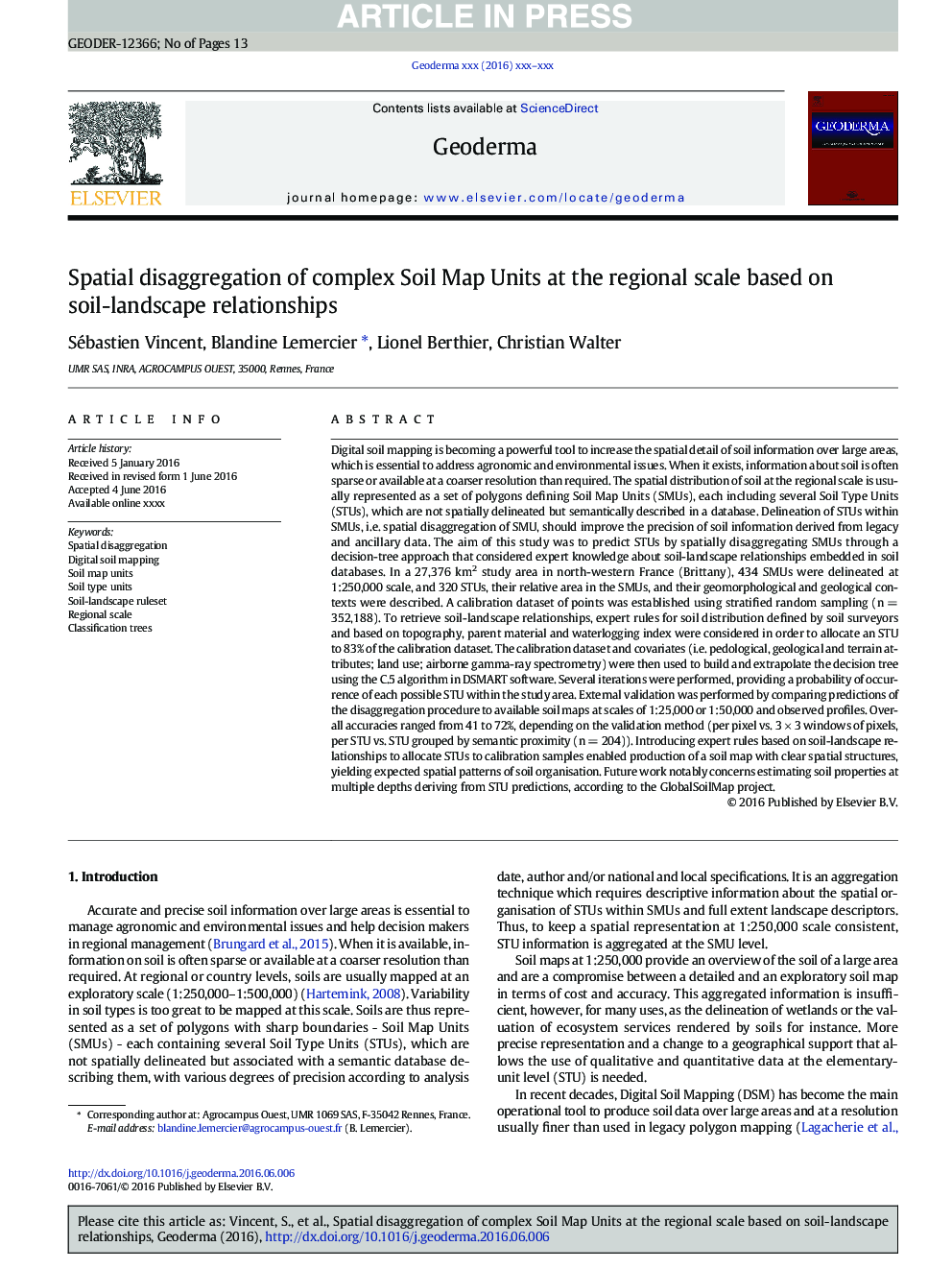| کد مقاله | کد نشریه | سال انتشار | مقاله انگلیسی | نسخه تمام متن |
|---|---|---|---|---|
| 8894400 | 1629406 | 2018 | 13 صفحه PDF | دانلود رایگان |
عنوان انگلیسی مقاله ISI
Spatial disaggregation of complex Soil Map Units at the regional scale based on soil-landscape relationships
ترجمه فارسی عنوان
تجزیه فضایی نقشه های پیچیده نقشه های خاکی در مقیاس منطقه ای بر اساس روابط خاک-چشم
دانلود مقاله + سفارش ترجمه
دانلود مقاله ISI انگلیسی
رایگان برای ایرانیان
کلمات کلیدی
تجزیه فضایی، نقشه برداری خاک دیجیتال، واحدهای نقشه خاک، واحدهای نوع خاک، تنظیمات منظره خاک، مقیاس منطقه ای، درختان طبقه بندی
موضوعات مرتبط
مهندسی و علوم پایه
علوم زمین و سیارات
فرآیندهای سطح زمین
چکیده انگلیسی
Digital soil mapping is becoming a powerful tool to increase the spatial detail of soil information over large areas, which is essential to address agronomic and environmental issues. When it exists, information about soil is often sparse or available at a coarser resolution than required. The spatial distribution of soil at the regional scale is usually represented as a set of polygons defining Soil Map Units (SMUs), each including several Soil Type Units (STUs), which are not spatially delineated but semantically described in a database. Delineation of STUs within SMUs, i.e. spatial disaggregation of SMU, should improve the precision of soil information derived from legacy and ancillary data. The aim of this study was to predict STUs by spatially disaggregating SMUs through a decision-tree approach that considered expert knowledge about soil-landscape relationships embedded in soil databases. In a 27,376 km2 study area in north-western France (Brittany), 434 SMUs were delineated at 1:250,000 scale, and 320 STUs, their relative area in the SMUs, and their geomorphological and geological contexts were described. A calibration dataset of points was established using stratified random sampling (n = 352,188). To retrieve soil-landscape relationships, expert rules for soil distribution defined by soil surveyors and based on topography, parent material and waterlogging index were considered in order to allocate an STU to 83% of the calibration dataset. The calibration dataset and covariates (i.e. pedological, geological and terrain attributes; land use; airborne gamma-ray spectrometry) were then used to build and extrapolate the decision tree using the C.5 algorithm in DSMART software. Several iterations were performed, providing a probability of occurrence of each possible STU within the study area. External validation was performed by comparing predictions of the disaggregation procedure to available soil maps at scales of 1:25,000 or 1:50,000 and observed profiles. Overall accuracies ranged from 41 to 72%, depending on the validation method (per pixel vs. 3 Ã 3 windows of pixels, per STU vs. STU grouped by semantic proximity (n = 204)). Introducing expert rules based on soil-landscape relationships to allocate STUs to calibration samples enabled production of a soil map with clear spatial structures, yielding expected spatial patterns of soil organisation. Future work notably concerns estimating soil properties at multiple depths deriving from STU predictions, according to the GlobalSoilMap project.
ناشر
Database: Elsevier - ScienceDirect (ساینس دایرکت)
Journal: Geoderma - Volume 311, 1 February 2018, Pages 130-142
Journal: Geoderma - Volume 311, 1 February 2018, Pages 130-142
نویسندگان
Sébastien Vincent, Blandine Lemercier, Lionel Berthier, Christian Walter,
